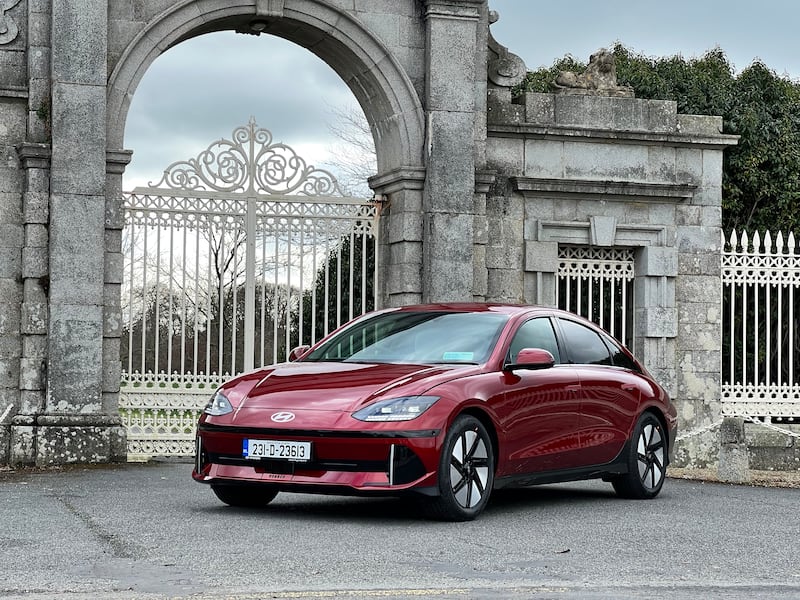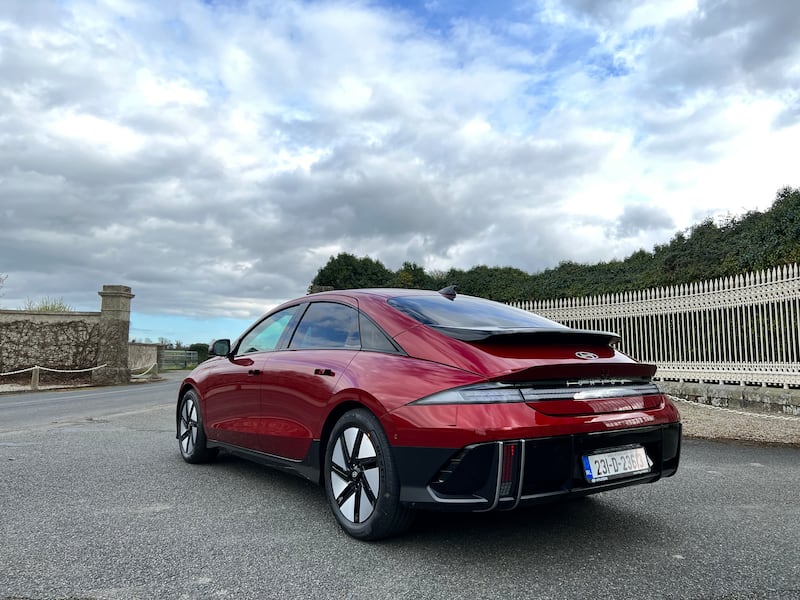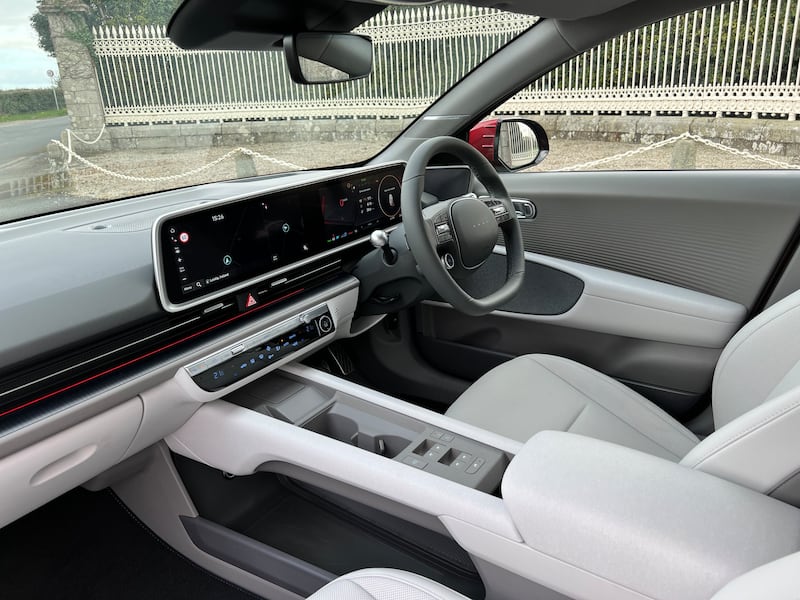It feels astonishingly good, novel almost, to be writing about a new car that’s not an SUV. The Ioniq 6 — for all Hyundai’s protestations that its body style needs to be referred to as a ‘Streamliner’ — is a four-door saloon, and it is all the better for it.
Its style is certainly challenging. A straw poll on Twitter (entirely unscientific, but hey ho…) seems to prove that the Ioniq 6′s styling is deeply divisive, a true Marmite car. Personally? I love it, and not merely because it’s #NotAnSUV. The rear is the arguably the best aspect, where there’s a complex interplay between lights, lines, and spoilers which looks one part Porsche, one part Tatra (Google it…). At the front, it’s more complex than it looks in photos, with neat little aero vanes in the front intake that snap shut to improve aerodynamics or open wide to help cool the battery pack.
The ‘Streamliner’ thing is not mere marketing puff either. The Ioniq 6 is truly sleek, matching the Mercedes EQS with a drag coefficient of 0.21Cd if you pick the optional rear-view cameras instead of conventional wing mirrors. Hyundai’s design team say that the shape of the car was inspired by a Peregrine Falcon diving at prey.
In spite of which, it’s a defiantly un-aggressive car. Where the Ioniq 5 — which uses the same E-GMP electric car platform and shares batteries and motors with the 6 —is a little in your face with its height and its angular styling, the Ioniq 6 slips easily and noiselessly by. It’s a subtle car, even with that styling.
READ MORE
Inside, there is space aplenty, and in spite of the sleek styling there’s lots of headroom and stretch-out legroom in the back seats. The boot is mildly disappointing, at 401-litres, but there is an extra bit of space in the ‘frunk’ under the bonnet, enough at least to store charging cables.

Not that you’ll need to charge all that much. The big-battery, rear-drive version of the Ioniq 6, which uses the same 77kWh battery pack as the Ioniq 5, and the same 229hp rear-mounted electric motors, has a claimed range of 614km. Even in very mixed driving, our quick test of the car seemed to show that 500km should be easily achieved, and 500km easy with a little attention to detail. Apart from the sleek aerodynamics, that range is achieved thanks to items such as a heat-pump cabin heating system.
The base model of the Ioniq 6 is almost as impressive in range terms, claiming 429km from a 53kWh battery — which just goes to show what an enormous difference sleek aerodynamics make. An equivalent Ioniq 5 gets 385km from the same battery and motor. There will also be a top-spec four-wheel drive Ioniq 6, with 326hp and a range of 519km (in part the range is reduced by optional 20-inch wheels, less sleek than the aero-friendly 18-inch wheels of the basic models).
The Ioniq 6 is astonishingly refined to drive. Indeed, when I stuck a Go-Pro camera to the outside of the car to shoot a little video, you could hear more wind noise from the camera mount than from the rest of the car. You can almost sense the way the car politely asks the air to step aside before slipping easily through. It’s so much nicer a sensation than the way a tall SUV bludgeons into its surroundings.

Its suspension occasionally thumps over a very difficult bit of tarmac, but for the most part the 6 rides pretty serenely, but it’s not quite a driver’s car — the steering is light and direct, but lacks feel and with that long — almost three-metre — wheelbase it’s not the most agile thing around. A rival Tesla Model 3 or BMW i4 have the Ioniq 6 beaten for driver appeal, but neither can match the Hyundai’s cabin space nor refinement, and the Tesla is way behind on build quality.
That said, there are some cheap plastics in the cabin, and the re-siting of the electric window switches to the centre console feels somehow a bit 1980s. The big twin screens look impressive, but can be slightly fiddly to use on the go, but at least Hyundai has kept separate controls for heating and air conditioning. You definitely need to spec yours with the ‘Premium Relaxation Seats’ because even though the driving position feels a little too high-set, they’re really comfy. Settle back and let the world pass silently by.

Prices? Well, the 6 is — slightly disappointingly, — more expensive than the Ioniq 5, and by quite a bit. The base 53kWh battery model starts from €48,295 which is some €7,300 more than the 5 with the same battery. The long range 77kWh ioniq 6 starts from €54,315 which is closer, but still €5,000 more than the 77kWh Ioniq 5.
True, the Ioniq 6 has slightly higher standard equipment levels, and more range (which is down to its body, not its technology) but it still seems a slight shame that the four-door couldn’t have been priced a little more sharply. You can choose from a well-equipped Signature model, or a ritzy Elegance which comes with leather seats, a higher level of driver assistance, a Bose stereo, and heated rear seats. There’s also a range-topping Finesse model which comes with the 20-inch wheels, more power, and the four-wheel drive system.
Those are pre-July prices too. After the SEAI grant gets cut in July, the price of a base Ioniq 6 will rise to €49,795, but that’s not quite the full story. According to Hyundai, if you order your new EV before June 30th, and get approval for your SEAI grant before that date, you can still register your new car up to four months later, and still get the full €5,000 grant. A buyer actually buying in July will only get the new €3,500 grant. There are also whispers that if you can show proof of a shipping or factory delay for your new car, you could potentially be registering a car in January next year and still get the €5,000 grant, although that leniency is more latent than promised.
This or a Tesla Model 3? This. The Hyundai’s quality and interior space are superior, and it matches the Tesla for range, if not for speed. This or an Ioniq 5? Trickier, as the Ioniq 5 gives you all the same tech for slightly less cash, and with a bigger boot into the bargain. Personally, this would be my choice, mostly because it’s not an SUV (even though the Ioniq 5′s SUV-ness is partially debatable). Sleek, slick, smooth, and silent. Polarising the Ioniq 6′s styling might be, but it’s an impressive piece of the aerodynamicist’s art, and that low-slung body pays serious range dividends.











